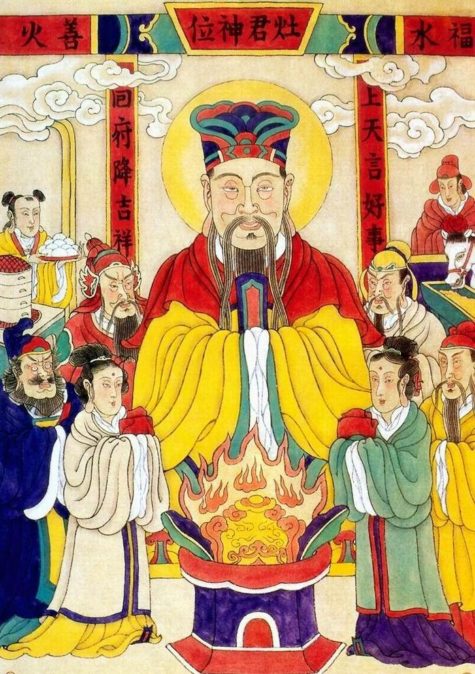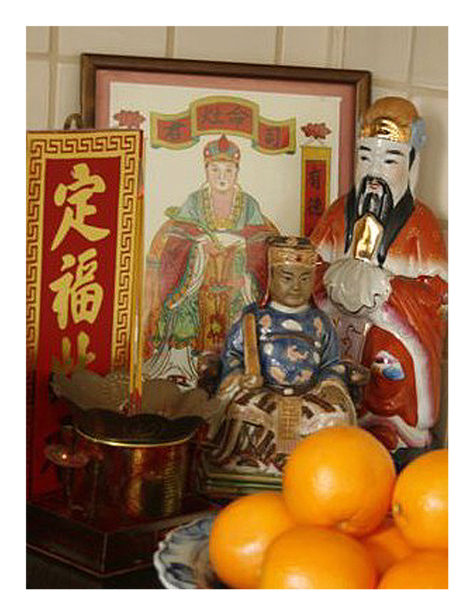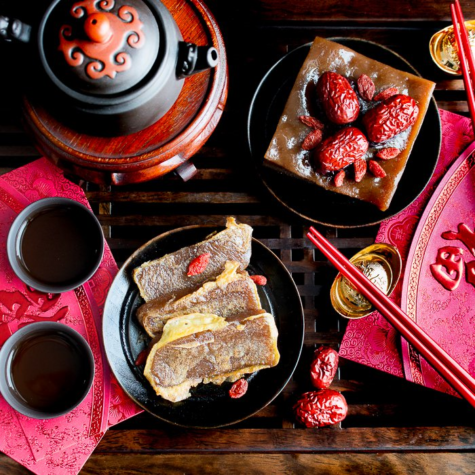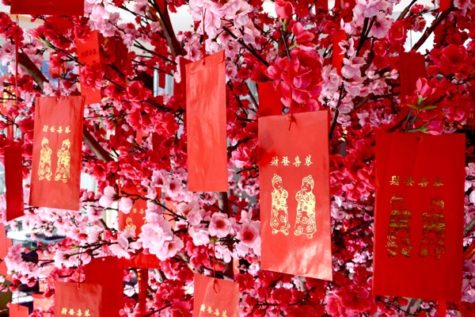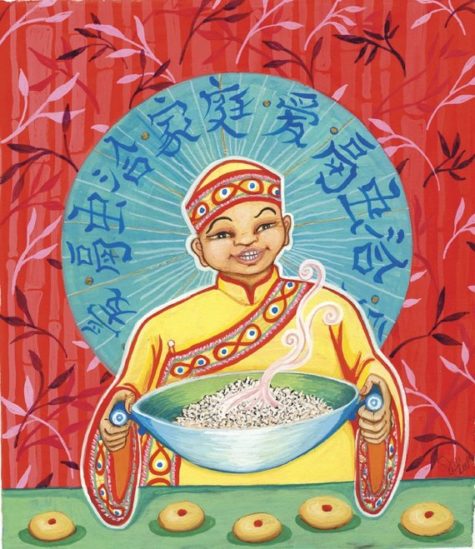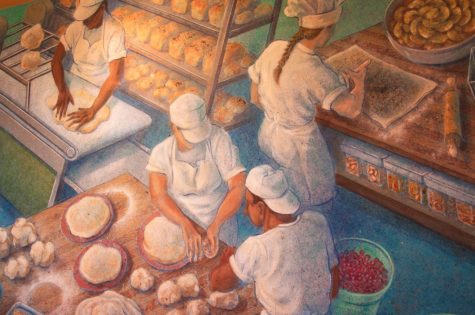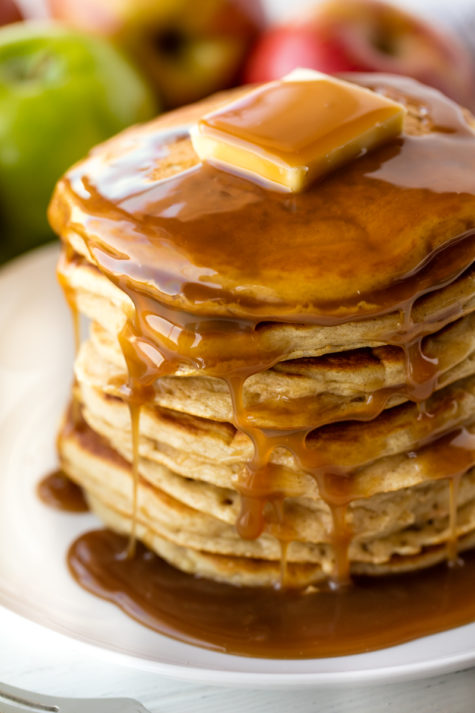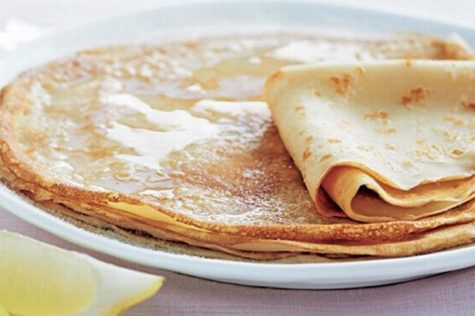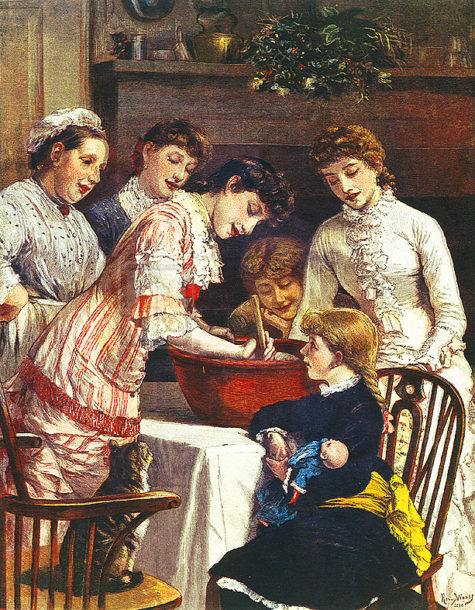Cooking
The Xiao Nian Festival (Little New Year) or the Kitchen God Festival occurs approximately a week before the Chinese New Year. The dates vary depending on the region, and from year to year.
It is believed that people in northern China celebrate it on the twenty-third day of the twelfth lunar month, while the people in southern China celebrate it on the twenty-fourth. Along with location, traditionally the date may also be determined by one’s Profession. For example, “feudal officials made their offerings to the Kitchen God on the twenty-third, the common people on the twenty-fourth, and coastal fishing people on the twenty-fifth”.
In 2019, in Taiwan, the festival will be celebrated on January 29.
It is believed that just before Chinese New Year, the Kitchen God returns to Heaven to report the activities of every household over the past year to Yu Huang, the Jade Emperor. Once in Heaven, the words of the Kitchen God influences the amount of prosperity and abundance that each family will have bestowed on them in the new year. The Jade Emperor, emperor of the heavens, either rewards or punishes a family based on Zao Jun’s yearly report.
In order to ensure that the Kitchen God speaks sweetly of the family, offerings of incense and bowls of ‘sweet treats’ such as ripe melons, honey, glutinous cakes, and sugar candies are presented for his delight before his image is burned and his journey begins.
Gold and silver ‘ingots’ fashioned from paper are also offered, and little paper-mache sedan chairs are sometimes provided to offer comfort on the journey to Heaven.
On this day, the lips of Zao Jun’s paper effigy are often smeared with honey to sweeten his words to Yu Huang (Jade Emperor), or to keep his lips stuck together. Incense and candles are lit around the house. Sticky sweets are left for the Kitchen God, usually on an alter or shrine. The stickier the candy the better, so the god’s mouth sticks closed and he can’t speak poorly of the family. According to custom, men must leave the sweets.
To send the god on his way, his picture is taken outside and the effigy is burned and replaced by a new one on Chinese New Year’s Day. Firecrackers are often lit as well, to speed him on his way to heaven. If the household has a statue or a nameplate of Zao Jun it will be taken down and cleaned on this day for the new year.
In days leading up to the Lunar New Year, people clean their houses, decorate their homes with paper cuttings, couplets and written blessings, and prepare festival food. After the cleaning is done, homes are decorated in red papercuts and posters, and fresh flowers.
In order to establish a fresh beginning in the New Year, families must be organized both within their family unit, in their home, and around their yard. This custom of a thorough house cleaning and yard cleaning is another popular custom during “Little New Year”. It is believed that in order for ghosts and deities to depart to Heaven, both their homes and “persons” must be cleansed. Lastly, the old decorations are taken down, and there are new posters and decorations put up for the following Spring Festival.
According to traditional Chinese culture, the kitchen god returns from heaven on the eve of Spring Festival, so the sacrifices for the god are served until the day he returns.
How Zao Jun Became The Kitchen God
Though there are many stories on how Zao Jun became the Kitchen God, the most popular one dates back to around the 2nd Century BC. Zao Jun was originally a mortal man living on earth whose name was Zhang Lang. He eventually became married to a virtuous woman, but ended up falling in love with a younger woman. He left his wife to be with this younger woman and, as punishment for this adulterous act, the heavens afflicted him with ill-fortune. He became blind, and his young lover abandoned him, leaving him to resort to begging to support himself.
Once, while begging for alms, he happened across the house of his former wife. Being blind, he did not recognize her. Despite his shoddy treatment of her, she took pity on him and invited him in. She cooked him a fabulous meal and tended to him lovingly; he then related his story to her. As he shared his story, Zhang Lang became overwhelmed with self-pity and the pain of his error and began to weep.
Upon hearing him apologize, Zhang’s former wife told him to open his eyes and his vision was restored. Recognizing the wife he had abandoned, Zhang felt such shame that he threw himself into the kitchen hearth, not realizing that it was lit. His former wife attempted to save him, but all she managed to salvage was one of his legs.
The devoted woman then created a shrine to her former husband above the fireplace, which began Zao Jun’s association with the stove in Chinese homes. To this day, a fire poker is sometimes referred to as “Zhang Lang’s Leg”.
Alternatively, there is another tale where Zao Jun was a man so poor he was forced to sell his wife. Years later he unwittingly became a servant in the house of her new husband. Taking pity on him she baked him some cakes into which she had hidden money, but he failed to notice this and sold the cakes for a pittance. When he realized what he had done he took his own life in despair.
In both stories Heaven takes pity on Zhang Lang’s tragic story. Instead of becoming a vampirish hopping corpse, the usual fate of suicides, he was made the god of the Kitchen, and was reunited with his wife.
Another possible story of the “Stove god” is believed to have appeared soon after the invention of the brick stove. The Kitchen God was originally believed to have resided in the stove and only later took on human form.
During the Han Dynasty, it is believed that a poor farmer named Yin Zifang, was surprised by the Kitchen God who appeared on Lunar New Year as he was cooking his breakfast. Yin Zifang decided to sacrifice his only yellow sheep. In doing so, he became rich and decided that every winter he would sacrifice one yellow sheep in order to display his deep gratitude.
Source:
The best days listed here are based on both the phase of the moon and its position in the zodiac. Many people believe that if you do the tasks on the dates listed, you will get the best results possible.
January
- Bake: 5, 6, 12, 13, 18, 19
- Brew: No good days
- Can Fruits and Vegetables: 1, 27, 28
- Dry Fruits and Vegetables: 21
- Jams and Jellies: 1, 27, 28
February
- Bake: 8, 9, 15, 16
- Brew: No good days
- Can Fruits and Vegetables: 23, 24
- Dry Fruits and Vegetables: 25
- Jams and Jellies: 3, 23, 24
March
- Bake: 7 – 9, 14, 15
- Brew: 5
- Can Fruits and Vegetables: 5, 22 – 24
- Dry Fruits and Vegetables: 25, 26
- Jams and Jellies: 2 – 4, 22 – 24, 29 – 31
April
- Bake: 5, 10 – 12, 17, 18
- Brew: 1, 2, 28 – 30
- Can Fruits and Vegetables: 1, 2, 19, 20, 28 – 30
- Dry Fruits and Vegetables: 21, 22
- Jams and Jellies: 19, 20, 26, 27
May
- Bake: 8, 9, 14, 15
- Brew: 26, 27
- Can Fruits and Vegetables: 26, 27
- Dry Fruits and Vegetables: 18 – 20
- Jams and Jellies: 3, 23 – 25, 31
June
- Bake: 4, 5, 10 – 12
- Brew: 22, 23
- Can Fruits and Vegetables: 22, 23
- Dry Fruits and Vegetables: 24
- Jams and Jellies: 1, 19 – 21, 27, 28
July
- Bake: 2, 8, 9, 14, 15
- Brew: 1, 19 – 21, 29, 30
- Can Fruits and Vegetables: 1, 19 – 21, 29, 30
- Dry Fruits and Vegetables: 22, 23
- Jams and Jellies: 17, 18, 24 – 26
August
- Bake: 4, 5, 11, 12, 31
- Brew: 15 – 17, 25, 26
- Can Fruits and Vegetables: 15 – 17, 25, 26
- Dry Fruits and Vegetables: 18 – 20
- Jams and Jellies: 21, 22
September
- Bake: 1, 7, 8, 28, 29
- Brew: 22, 23
- Can Fruits and Vegetables: 22, 23
- Dry Fruits and Vegetables: 14 – 16
- Jams and Jellies: 17, 18
October
- Bake: 4, 5, 12, 31
- Brew: 19, 20
- Can Fruits and Vegetables: 19, 20
- Dry Fruits and Vegetables: 13
- Jams and Jellies: 14, 15
November
- Bake: 1, 2, 8, 9, 28, 29
- Brew: 15, 16
- Can Fruits and Vegetables: 15, 16, 24, 25
- Dry Fruits and Vegetables: 17, 18
- Jams and Jellies: 12, 24, 25
December
- Bake: 5 – 7, 26, 27
- Brew: 12, 13
- Can Fruits and Vegetables: 12, 13, 21, 22
- Dry Fruits and Vegetables: 14 – 16
- Jams and Jellies: 21, 22
Source: The Farmer’s Almanac
The Noumenia is the first day of the visible New Moon and is held in honor of the household Gods. The Noumenia is also considered the second day in a three day household celebration held each lunar month – Hekate’s Deipnon is on the last day before the first slice of visible moon and is the last day in a lunar month, then the Noumenia which marks the first day in a lunar month, followed by the Agathos Daimon (Good Spirit) on the second day of the Lunar month.
The Noumenia is a celebration of the start of a new Hellenic month and seeks blessings for the household. Offerings such as incense or honey cakes are made to your household Gods at your family altar.
- Here’s a recipe for Ancient Hellenic Honey Cakes.
Traditionally, the household Gods consist of Hestia, Zeus Ktesios, Hermes, Hekate, Apollon Agyieus, your household’s Agathos Diamons and can include any ancestors you honor. However, many Hellenic Polytheists do honor more Gods at their family altar.
You can celebrate the Noumenia with the following rituals:
- Decorate their home with fresh flowers, evergreen branches, or other seasonal decorations.
- Serve a big family meal and eat it at the dining room table.
- Create a list of family goals or projects to get done or start within the next lunar month.
- Bake a special dessert that you only make on this day – such as Honey Cake.
- Like the ancient Athenians, you can burn frankincense and read the Orphic and Homeric hymns to Selēnē.
- Replace the ingredients in the Kadiskos (see below) with fresh water, oil, and fruit, and bits of food.
The Kadiskos is a small jar containing food stuffs that we receive from the Gods and give back in reciprocity. Refreshing the Kadiskos is part of preparing for Noumenia. Here are directions for Making a Kadiskos.
Hellenic Worship:
Hellenic worship makes notice of the New Moon, because it marks the beginning of the month, rather than the more obvious full moon, although many Hellenic festivals are held during or near the time of the full moon.
“The first day of the month was new moon day (noumēnia), recognized as a holy day throughout the Greek world. It was so holy that at Athens, no other festival ever took place that day. It was celebrated by a public ritual on the Acropolis and by private offerings of frankincense to statues of the gods.”
Herodotus says that, in Sparta, meat, barley meal and wine were distributed to the citizens by the Kings on the Noumenia.
Hymn To Selene
Orphic Hymn 9 to Selene says that she “Delights in stillness and in the kindly, auspicious night.” Many of the Orphic hymns, and this one especially, reminds us that the arrival and passage of each new month is a reflection of the cycle of lives, with birth following the period of dark death. So as She is “a sure token and a sign to mortal men,” so we can trust in the cycle of rebirth and renewal.
Orphic Hymn 9 ~
Fumigation from Aromatics
Hear, goddess queen (thea basileia), diffusing silver light, bull-horned, and wandering through the gloom of night.
With stars surrounded, and with circuit wide night’s torch extending, through the heavens you ride: female and male, with silvery rays you shine, and now full-orbed, now tending to decline.
Mother of ages, fruit-producing Mene (Moon), whose amber orb makes night’s reflected noon: lover of horses, splendid queen of night, all-seeing power, bedecked with starry light, lover of vigilance, the foe of strife, in peace rejoicing, and a prudent life: fair lamp of night, its ornament and friend, who givest to nature’s works their destined end.
Queen of the stars, all-wise Goddess, hail! Decked with a graceful robe and amble veil.
Come, blessed Goddess, prudent, starry, bright, come, moony-lamp, with chaste and splendid light, shine on these sacred rites with prosperous rays, and pleased accept thy suppliants’ mystic praise.
More Hymns, Prayers, and Invocations can be found at Widdershins.
A Prayer For The Noumenia
In honor of the Noumenia of Anthesterion:
I have seen the moon
thin curved glow
hovering on delicate breeze
divine above the pink horizon
gentle horns pointing
toward tomorrow
We are all re-born now
owning no past
Yesterday is cleansed
complete
Greetings to you,
Goddess!
Guide us around
the next cycle of life
until we meet again
May we use it wisely
~ by Melissa
Source: Hellenion.org

When you read the ancient and scholarly texts having to do with ancient Hellas, you will often come upon references to ‘honey cakes’ or ‘cakes’ in general. We might be tempted to interpret these to mean modern day cakes, but the ancient Hellenes would have most likely used flat cracker-type ‘cakes’, made from barley meal and honey. They were shaped to resemble animal or objects when the occasion called for it. unfortunately, no ancient recipe from Hellas has survived; perhaps because these cakes were known to all and passed down from mother to daughter from an early age. There was perhaps no need to write the recipe down at all.
The following recipe comes from an Alexandrian professor, Julius Pollux, who lived in the 2nd century CE. This is a simple, very basic recipe that may well have been used by the ancient Greeks and Romans.
Ingredients
- 200 g barley flour
- 100 ml water
- 3 tbsp clear honey
- 2 tbsp olive oil
These measurements will make enough cakes to sacrifice to the entire pantheon; I used half of these measurements (but see notes below) and ended up with five large cakes; far more than any sacrifice might call for. A quarter, or even an eighth, of the ingredients will make enough for an entire Noumenia sacrifice.
Preparation
Place the flour in a bowl, add the honey and olive oil and mix. Pour in the water little by little and continue mixing until a good dough is formed. Cool this in the fridge for about then minutes. I have found that using a quarter less water makes a better dough.
Tip the ball of dough onto a floured surface and roll out as thinly as possible. Use a pastry cutter to cut the dough and place the rounds on a greased baking tray.
The original recipe says to bake the cakes in an oven pre-heated to 200°C for about 15 minutes. I would suggest no more than twelve minutes, and will follow my own advice next time.
Transfer the cakes to a wire rack, cool and sacrifice. If you have made too many, save them in an air-tight container. The advantage of honey is not just its sweet taste, but its ability to keep pastry fresh for a long time, as it is an excellent liquid absorbent.
Source: Baring The Aegis
Different countries and cultural traditions have different names for this day. Popular names include Pancake Day or Pancake Tuesday, Mardi Gras, Tłusty Czwartek, Fasnacht Day, Tuesday of Carnival, Fat Tuesday, and Shrove Tuesday. Shrove Tuesday is the last day of Shrovetide.
Pancake Tuesday always falls 47 days before Easter Sunday, so the date varies from year to year and falls between February 3 and March 9. In 2019 Pancake Tuesday will fall on March 5th.
During Lent, which begins the next day (Ash Wednesday), rich foods are not eaten; therefore the day before pancakes, donuts and other treats are cooked to use up the ingredients in the house. Pancake Tuesday was the last opportunity to use up eggs and fats before embarking on the Lenten fast and pancakes are the perfect way of using up these ingredients.
Pancakes are eaten with a sprinkling of sugar, and they are served with syrup. The day celebrated by excessive pancake devouring is observed in the United Kingdom, Ireland, Australia, Canada, Denmark, France, Poland, Sweden, and in parts of the United States.
Today just might be the perfect day to take a look at the following posts about pancakes:
What are pancakes?
A pancake is a thin, flat cake, made of batter and fried in a frying pan. A traditional English pancake is very thin and is served immediately. Golden syrup or lemon juice and caster sugar are the usual toppings for pancakes.
The pancake has a very long history and featured in cookery books as far back as 1439. The tradition of tossing or flipping them is almost as old: “
And every man and maide doe take their turne,
And tosse their Pancakes up for feare they burne.”
~Pasquil’s Palin, 1619.
The ingredients for pancakes can be seen to symbolize four points of significance at this time of year:
- Eggs ~ Creation
- Flour ~ The staff of life
- Salt ~ Wholesomeness
- Milk ~ Purity
To make 8 or so pancakes you will need the following:
- 8oz plain flour,
- 2 large eggs,
- 1 pint milk,
- salt.
Mix all together and whisk well. Leave to stand for 30 minutes. Heat a little oil in a frying pan, pour in enough batter to cover the base of the pan and let it cook until the base of the pancake has browned. Then shake the pan to loosen the pancake and flip the pancake over to brown the other side.
Pancake Races
In the UK, pancake races form an important part of the Shrove Tuesday celebrations – an opportunity for large numbers of people, often in fancy dress, to race down streets tossing pancakes. The object of the race is to get to the finishing line first, carrying a frying pan with a cooked pancake in it and flipping the pancake as you run.
The most famous pancake race takes place at Olney in Buckinghamshire. According to tradition, in 1445 a woman of Olney heard the shriving bell while she was making pancakes and ran to the church in her apron, still clutching her frying pan. The Olney pancake race is now world famous. Competitors have to be local housewives and they must wear an apron and a hat or scarf.
Each contestant has a frying pan containing a hot pancake. She must toss it three times during the race. The first woman to complete the course and arrive at the church, serve her pancake to the bellringer and be kissed by him, is the winner.
At Westminster School in London, the annual Pancake Grease is held. A verger from Westminster Abbey leads a procession of boys into the playground where the school cook tosses a huge pancake over a five-metre high bar. The boys then race to grab a portion of the pancake and the one who ends up with the largest piece receives a cash bonus from the Dean.
Source: Historic UK
Stir-up Sunday is an informal term in Anglican churches for the last Sunday before the season of Advent. It gets its name from the beginning of the collect for the day in the Book of Common Prayer, which begins with the words, “Stir up, O Lord, the wills of thy faithful people”. But it has become associated with the custom of making the Christmas puddings on that day.
Why not blend the best of both worlds? Invoke the Goddess Hestia’s blessing in your kitchen and make some pudding for the whole family (or a gathering of friends). Traditionally, families gather together in the kitchen of their homes to mix and steam Christmas pudding on Stir-up Sunday. Parents taught their children how to mix ingredients for the pudding. Everyone took a turn to stir the pudding mix for each person involved is able to make a special wish for the year ahead. Practically, stirring the mixture is hard work, therefore as many as possible are involved.
By tradition the pudding mixture is stirred from East to West in honor of the three wise men who visited the baby Jesus.Have each person present stir the pudding clockwise for a few minutes as they focus on a wish. By next year at this time, the wish should manifest.
It was common practice to include small silver coins in the pudding mixture, which could be kept by the person whose serving included them. The usual choice was a silver threepence or a sixpence. The coin was believed to bring wealth in the coming year. Other tokens are also known to have been included, such as a tiny wishbone (to bring good luck), a silver thimble (for thrift), or an anchor (to symbolise safe harbour).
On a historical note:
The Christmas pudding is one of the essential British Christmas traditions and is said to have been introduced to Britain by Prince Albert, husband of Queen Victoria (the reality is that the meat-less version was introduced from Germany by George I in 1714.). Most recipes for Christmas pudding require it to be cooked well in advance of Christmas and then reheated on Christmas day, so the collect of the day served as a useful reminder.
About Hestia:
The Greek goddess of household affairs, Hestia watches over our cookery today to help manifest family unity and ensure tasty outcomes. As a hearth goddess, she provides the spiritual energy necessary to keep our faith sure and the inner fires burning bright. Greek art did not try to portray this goddess, because she was considered the beginning – the source from which all else was ignited and set in motion.
Light a candle this morning to welcome Hestia’s unity and energy into your home. Or, carry matches in your pocket so the spark of this goddess can ignite in any situation where it’s needed. Throughout the day, when you need more commitment to your beliefs, just light one match to invoke Hestia’s aid.
Collected from various sources
